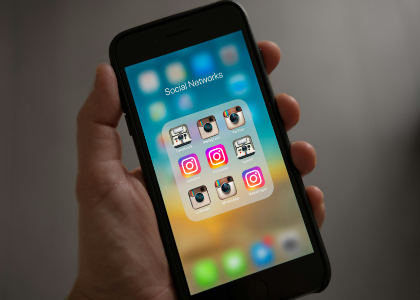Blog

Sustainable Logo Design: Green Logo Elegance
A logo is a visual representation of a business or brand. Making a good impression is crucial because it is typically what people notice initially. A sustainable logo can help to showcase a company's values and connection to environmental protection and social responsibility.
What is a Sustainable Logo?
A sustainable logo is a logo that uses natural symbols, earthy colors, and simple, elegant designs to represent a company's commitment to sustainability. The goal of a sustainable logo is to create a positive image of the organization and its environmental values.
Why is it Important?
Sustainable logos are essential for several reasons. First, they can help to increase awareness of environmental issues. Second, they can attract customers interested in cooperating with eco-friendly companies. Third, they can help to build a positive brand image for the company.
There are numerous approaches to making a sustainable logo. Some common elements include:
- Natural symbols, such as leaves, flowers, or water
- Earthy colors, such as green, blue, or brown
- Simple, elegant designs
- A focus on typography
The Psychology Behind Eco-Friendly Logos
Psychology plays a pivotal role in logo design. Green logo elegance leverages the psychology of colors to create a sense of harmony and eco-friendliness. Shades of green evoke nature, tranquility, and growth, while blue hints at clear skies and water. Such colors draw in environmentally aware customers and build reputation and trust.
Showcasing Eco-Friendly Initiatives
Green logo elegance is more than just a design; it symbolizes a company's commitment to sustainability. Brands can use these logos to highlight their eco-friendly initiatives, such as using renewable materials, reducing waste, and supporting conservation efforts. A feeling of authenticity can be created by the harmony between the visual identity and the actions taken in reality.
Business Name and Logotype
The business's name can also be essential to a sustainable logo. The name must be connected to the company's objectives and guiding principles. It should also be easy to remember and pronounce. In some cases, the name itself can be the logotype. So, consider every detail before choosing a name for a brand or company. You can easily use business name generator apps and platforms to make this vital task more manageable.
Sustainable logo examples
Here are a few real-life famous examples of sustainable logos that beautifully represent the idea of elegant green branding:
Starbucks: The Starbucks logo features a simple, iconic image of a twin-tailed mermaid, or siren, surrounded by a green circle. The green color in the logo symbolizes the brand's commitment to environmental sustainability and natural ingredients.
Greenpeace: Greenpeace's logo showcases a bold, vibrant green letter "G" that doubles as a person raising their arms in a gesture of peace and protection. The logo's simplicity and use of color communicate the organization's dedication to eco-friendly causes.
Whole Foods Market: The Whole Foods logo combines a green leaf and the brand's name in lowercase letters. The leaf design reflects the brand's emphasis on organic and sustainable products, while the lowercase letters create a friendly and approachable vibe.
Holiday Inn: The Holiday Inn logo is a white letter H in the foreground of green color. The green color evokes a sense of nature and renewal, aligning with a relaxing and eco-conscious hospitality experience.
Sprite: The logo showcases a dynamic, minimalist design with a prominent, lime-green "S" surrounded by a lemon-yellow backdrop. The vibrant green and yellow colors reflect the zesty and refreshing qualities of the drink. The logo's simplicity and lively colors make it stand out and easily recognizable, aligning with the brand's image of crisp and refreshing beverages.
Tropicana: Tropicana's logo showcases the brand name with a green leaf attached. The use of green highlights the freshness of the juice and the brand's commitment to natural ingredients.
Subway: Subway's logo features the brand name in bright green letters, with an arrow-like design extending from the "S." Green signifies freshness and health, aligning with the brand's focus on customizable and nutritious sandwiches.
John Deere: John Deere's logo showcases a leaping deer in a vibrant shade of green, set against a yellow backdrop. The green color represents growth and the agricultural industry, which is the core of John Deere's business, while the leaping deer symbolizes progress and forward movement in farming technology.
Hulu: Hulu's logo features the brand name in a vibrant shade of green. The use of green represents the streaming service's energetic and innovative approach to entertainment.
TicTac: TicTac's logo presents the brand name against the green leaf background. The green leaf choice reflects the refreshing and minty flavors of the product, creating a connection between the logo and the taste experience.
Collages and Sustainable Logos
Collages are art that combines many items, including pictures, newspaper snippets, and paint, to create a new image. Sustainable logos can be inspired by collages, as they often use a variety of natural elements to create a unique and visually appealing design.
For example, the Ecover logo features a clean and modern design with the brand name in lowercase letters and a leaf-like emblem on top. The logo's color palette includes shades of green and blue, which convey the brand's commitment to eco-friendly cleaning products and sustainable practices.
The logo for the company Patagonia uses a mountain range as its logo. This inspires a feeling of adventure and curiosity pertinent to the business's goods and services.
Summary
In conclusion, a sustainable logo embodies a company's dedication to environmental responsibility through natural symbols and elegant designs. These logos raise awareness, attract conscious customers, and enhance brand image. By using earthy colors like green and blue, brands create a trustworthy and eco-friendly vibe. Green logo elegance is committed to sustainability, aligning visual identity with real-world actions like using renewable materials. The business name, relevant and memorable, plays a vital role in a sustainable logo. Famous examples include Starbucks, Greenpeace, and Whole Foods, where simplicity and color reflect their eco-friendly values. Collages inspire such logos, combining natural elements for a unique design, as seen in brands like Patagonia.
About the author:
Elen Mesropyan is an experienced web content and report writer at LinkyJuice.
She has a passion for creating engaging and informative articles. She mainly specializes in SEO-optimized content and IT-related articles. With a background in marketing, she always writes copy that leaves a lasting impact on readers.
More tips and tricks on the blog


